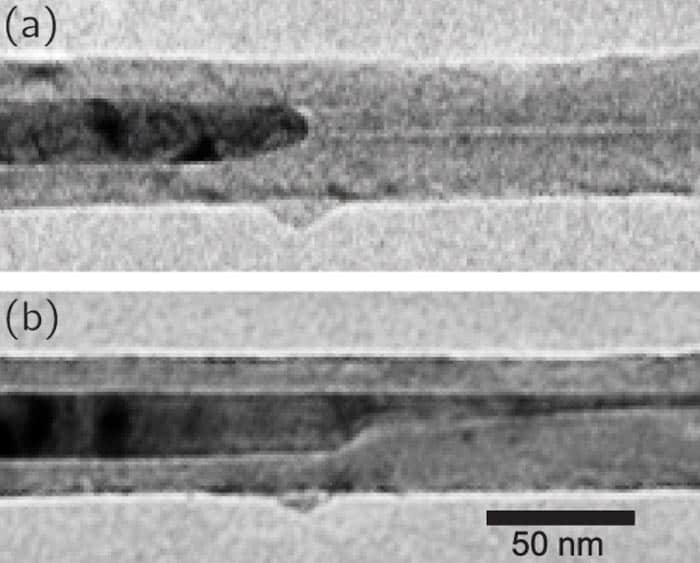
Researchers in the US have made a remarkable discovery about how an iron nanocrystal moves through a carbon nanotube that does not have a uniform diameter. They found that if the crystal meets a constriction in the tube, the crystal reforms, atom by atom, to fit through the constriction, without undergoing any melting or compression. According to the researchers, this behaviour could have many applications in nanomechanics and could possibly be used to synthesize small nanoparticles.
Scientists already knew that metallic nanocrystals can be made to travel through carbon nanotubes (CNTs) if a current is applied to the tube. The crystal moves in the direction of the electron flow and can easily be made to move back and forth by switching the polarity of the current, while the speed of the movement depends on the current magnitude. Indeed, this has been tested with numerous metallic nanocrystals including copper, tungsten and gallium. This is of particular interest to those developing nanoscale actuators or memory devices, and for the removal of minute impurities from within the metal crystal. Previously, most of the CNTs used to study this “electromigration” were smooth and had a constant inner-diameter hollow core. But if for some reason the CNT narrowed down at some point, such that the nanocrystal was now bigger than the tube itself, it was assumed that the crystal would block the tube until it melts and flows through as a liquid.
Slipping through
Surprisingly, what Sinisa Coh and colleagues from the University of California, Berkeley, and Lawrence Berkeley National Laboratory found was very different. The metallic nanocrystals, while remaining solid and crystalline, somehow managed to slip through the narrow passage while not being deformed. Rather, the researchers found the crystal deconstructing and reforming within the narrow passage, at the atomic scale. The team watched the movement of iron nanocrystals with a high-resolution electron microscope. Electron diffraction measurements verified that the crystals did not melt or experience compression.

The team used CNTs that had an inner diameter of 20 nm, filling them with the iron nanocrystal. Halfway along the axis of the CNT, a constriction was created, where the width of the CNT narrowed down to about 5 nm. When the current was passed across the tube, the crystal managed to squeeze through the much smaller passage.
Rebuilding crystals
Coh and colleagues use their atom-by-atom reconstruction theory to explain this transport, saying that “at the ‘contact region’ [where the crystal is in contact with the inner wall of the CNT], surface atoms from the far end of the crystal are transported along to the front, where they then remain stationary”. Coh explains that once an atom has diffused from the back and has migrated to the front of the crystal, it quickly gets covered by more incoming atoms and so becomes part of the bulk and remains stationary. This effectively allows the entire crystal to re-assemble within the confines of the constriction with its bulk remaining essentially stationary, so long as the current is applied.
Coh points out that their theory is simple as the entire motion of the nanocrystal is modelled only on two parameters – the diffusion barrier height B and the period L – regardless of the length, area or temperature of the CNT or the magnitude of the electromigration force. “The crystal always moves at the same speed, however long or short it is, so long as you provide the current,” he says.
Coh told physicsworld.com that this type of atomic-scale reassembly could prove very useful to either synthesize certain metal crystals within CNTs or to purify them. “It might be possible to coat one metallic crystal with another and then deposit only one within a CNT if you are building a nanoacale device…or you could get rid of defects by removing slower-migrating contaminants from a crystal as the surface-atom movement is dependent on the type of atom,” he says. He also says that the theory could be used to put multiple metallic species into the same CNT, or into CNTs that have complex, undulating geometries.
The research is published in Physical Review Letters.



